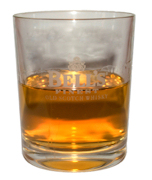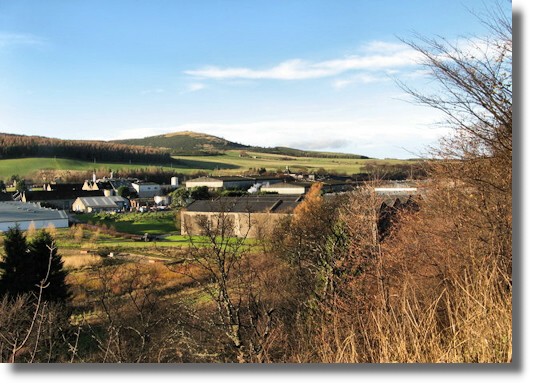

Whisky Connoisseur
Arthur J A Bell
Caskmaster's Selection No 1


Whisky Connoisseur
Arthur J A Bell
Caskmaster's Selection No 1

Photo of Dufftown Distillery Complex by Christopher Gillan, via Wikimedia

There are some things so rare, and so precious, we hardly dare tell folk of them for fear of being swamped with reservations we are unable to fulfil. Such a commodity sits beside me now in a nosing glass as I write to you. It is releasing a wondrously fruity aroma - of deep mystery and promise - of delights to come.Before I go on, let me explain a little of the fascinating history and provenance of Dufftown's oldest (of nine) stills. The distillery nestles in a hollow in this high Banffshire hill village. Beside it is the churchyard of St. Moluage where a battle stone records a conflict here between the Scots of king Malcolm II and the Danes in the year 1010. In the 18th century, illicit distilling took place on the site, using as its water source the pure clear drawings from "Highland John's Well" of Conval Hills.
In 1832, the Excise Act was passed. Three Dufftown men leased a feu from the Earl of MacDuff, and took out a License thus gaining what Sir Robert Bruce Lockhart calls, "the doubtful distinction of owning one of the earliest licenced distilleries in the Highland kingdom of whisky".
Within 20 years, it appears that the neighbouring Grants of Rothes had removed the stills, and the distillery was silent except for Sundays. The Church of Scotland suffered a major schism - The Great Disruption - and the Free Kirk met each Sabbath for a service in the distillery! Did they seek ‘the angels share' one wonders?
By 1854, however, the last surviving founder was back in business, and he brought in Mr. George Cowie. Cowie was to build the fame of Mortlach-Glenlivet far and wide. Even to the heart of Empire, London itself. In 1903 , Mr. Cowie carried out a major expansion and rebuilt the original distillery. He was joined as a partner by a medical practitioner from Hong Kong, his son, Dr. A. M. Cowie. It remained a further two decades in the family before John Walker & Sons took it over as a Dufftown's largest producer of fine malt. Within two years, it had joined D.C.L., who rebuilt it again in the early 1960's. Today it is one of the gems in the mast stable of United Distillers, plc.Now back to Caskmaster's Selection No 1. During the sunny autumn of 1974, a Morayshire farmer harvested his Golden Promise barley. After storage, it was taken to the Morthlach's own maltings (now converted to an engineering workshop). Over fires of peat from the Grampians, the barley was gently peated, and the mash slowly distilled, to give a robust aromatic and estery, peated spirit. All under the direction of Mr. John Connon.
However, far, far away, west of the Missouri, and south of St. Louis, lie the Ozark Mountains (pictured on the right). Before the water from the Conval Hills, barley from Morayshire and peat from the Grampians, were combining to produce as fine a spirit as ever one tasted, Mr. Leroy McGinnies had been at work. Mr. McGinnies is widely regarded as the master cooper of Missouri. Taking native American Oak from the Ozarks, he crafted a hogshead that was, 4,500 miles away, to become number 6261 at Mortlach.Filled with the Banffshire Highland Spirit, it went to bed on the 27th of August 1975. In an ancient bonded warehouse, with a earthen floor, slate roof and black, black stone walls. This distinctive blackening is caused by a bug in the alcohol (a form of penicillin) attacking the stones as angels get their share of evaporating whisky. (In fact, our heavenly friends picked up 40%, or the equivalent of 144 bottles, from Cask 6261! What's more, we have to pick up the tab for the missing bottles that the cherubim and seraphim have been singing over!)
Now that we have bottled this nectar, what are the principal characteristics that you will discover in Caskmaster Selection No. 1? As you pour you will see a beautiful amber and gold liquid. You will catch a wonderful fruity aroma - hinting of peardrops and, caused by the combination of peat and oak, a sort of honeyed vanilla. You may also discover a slightly burnt heather and mild peat touch to it.After breathing for a few minutes, it gets slightly sweeter - this is what the angels were after. I would advise you inhale deeply as they've had more than enough already! You will find it incredibly , unbelievably smooth. It's sweetish on the centre of the tongue and dry towards the edge of the palate. Adding 50% water does not damage in any way the perfumed flavours exploding in your mouth. And what a superb, lingering after taste that maintains the mystery of this warming perfection of the distillers art. Quite simply - it's breath taking!
Return to Index of articles on Whisky by the Whisky Connoisseur, Arthur J A Bell
Where else would you like to go in Scotland?

